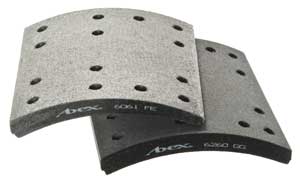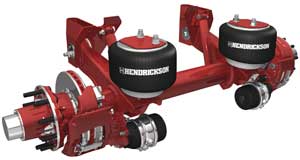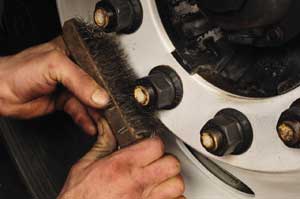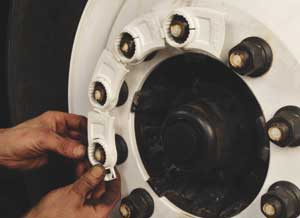As of Aug. 1, 2011, the first phase of the Federal Motor Vehicle Safety Standard (FMVSS) 121 reduced stopping distance regulation requires a loaded Class 8 tandem axle tractor with 59,600 GVWR or less to stop in 250 ft. from 60 mph, down 30% from a previous standard of 355 ft. Phase two, which goes into effect in August 2013, mandates shorter stopping distances for 6×4 severe service tractors and all 4×2 power units.
The first phase of the new stopping distance regulations covers approximately 70% of all new tractors built after Aug. 1 of last year. Air disc brakes, a technology previously considered mainly for bus, coach, fire truck and other special applications, have been experiencing continued growth in popularity on North American commercial vehicles used in on-highway operations. Fleets are increasingly interested in air disc brakes for safety performance and their potential for reduced maintenance requirements.
There is ample evidence that air disc brakes can meet or exceed new stopping distance regulations. However, suppliers are still hard at work addressing an ongoing challenge. In particular, the concern has to do with ensuring proper balance when tractors are equipped with disc brakes on steer axles and drum brakes on drives, a fairly common specification, or when an air disc brake-equipped tractor is hooked to a trailer with a drum brake system, or vice versa.

Valid concerns
“Air disc brakes are excellent products. They are becoming more available, and are now standard on some vehicles,” says Jim Clark, director of engineering at TMD Friction North America, a manufacturer of brake friction materials for OE and aftermarket use on commercial vehicles. “While there is a lot more interest among fleets, there also are valid concerns.
“The issue is incompatibility when disc brakes tend to keep working and drum brakes fade, generating less braking power,” Clark explains further. “In certain conditions, this can prematurely wear out the disc pad, or even initiate rotor cracking. Two design factors contribute to this. First, a drum brake uses lining blocks primarily made from high temperature resins, whereas a disc brake typically uses metallic-based linings. The metallic pad can operate at higher temperatures better than the drum lining.
| Air disc brake choices |
| Bendix Spicer Foundation Brake Bendix ADB22X air disc brakes have a two-pin floating caliper, as well as a specially designed 17-in. rotor coupled with proprietary friction material designed to optimize performance at high temperatures, and dual internally adjusted pistons for precise adjustment. The ADB22X is designed to fit most truck wheel-end envelopes so the same size brake unit can be used on all axles. www.foundationbrakes.comHendrickson Trailer Suspension Systems Trailer air disc brakes from Hendrickson are available as options on many Intraax and Vantraax trailer suspension systems as well as TRLAxle trailer axles. Hendrickson offers complete air disc braking solutions matched with several wheel-end and spindle options and has a unique torque plate that accommodates multiple air disc brake designs. The fully dressed air disc brake packages include disc brake calipers, air chambers, lining pads, hub and rotor assembly, bearings, seals, hubcaps and lubricant. www.hendrickson-intl.com Meritor WABCO |
“Secondly,” Clark continues, “there is a mechanical difference in the way drum and disc brakes react to increased temperature. When the brake drum heats up, its surface actually moves away from the lining as the drum expands. Conversely, when the disc heats up, it moves closer to the pads.
More compatible
Manufacturers agree that the air system should generally not be adjusted to correct for this phenomenon, Clark states, and that crack pressures should remain the same. Instead, the answer could partly be found in the disc brake pad’s friction material, in a pad that is designed to fade so its high temperature performance is more compatible to a drum brake’s lining.
TMD, Clark reports, is working with brake system manufacturers and vehicle OEMs to focus on building fade into disc brake pads. “The most important thing we’re finding,” he says, “is that properly formulated air disc brake pads may help address a basic incompatibility between disc and drum brakes caused by differences in their structures and lining materials.”
Federal-Mogul Corp., a global OEM friction manufacturer and supplier of friction products for the replacement market, is also working to address concerns about balance between air disc and drum brake systems on tractor-trailer combinations.
Stable characteristics
“Manufacturers need to design in the most consistent and stable friction characteristics to make sure the torque outputs are similar in profile between air disc and drum brake in tractor/trailer combinations,” says Greg Vyletel, commercial vehicle friction engineer.
“The key is to balance friction stability and torque outputs between the front and rear,” Vyletel continues. “It’s a delicate balance to make sure you have the right combination so the front is not doing all the work, and vice versa.”
Another concern, TMD’s Clark notes, is the lack of an aftermarket brake lining performance standard. “If a new air disc-equipped tractor is hooked to a drum-braked trailer with poor performing linings,” he says, “the risk of incompatibility can be increased.”
Replacement linings
In mid February, TMD Friction announced that its premium air disc brake pad friction material, T3070, has met the FMVSS 121 dynamometer requirements of TMC’s Recommended Practice 628—Aftermarket Brake Lining Qualification, as verified by SAE’s Performance Review Institute. As a result, TMD’s friction material for 225 size calipers is the first and only air disc pad listed on TMC’s list of approved replacement linings.
In addition, TMD’s premium drum brake lining, T5000, also has passed RP 628 qualification testing for standard 16.5×7 drum brakes. Together, these two products offer the first TMC-approved replacement option for newer tractor designs with air disc brakes on steer axles and drum brakes on drive axles, a configuration recently released as standard or optional on all major truck manufacturers’ vehicles. The compatibility issue with different brake designs on front and rear axles was a major reason TMD developed and certified to aftermarket standards a disc brake pad formulated to replicate the performance of drum lining material.
Easier to maintain
Air disc brakes also can be easier to maintain. The design of these systems often includes bolt-on components, making replacement simpler. In addition, the relatively simple caliper, pad and rotor design can mean faster disc brake pad removal and installation times compared to drum brakes, and not require specialized tools.
Today’s air disc brakes are dramatically improved over earlier versions, when service replacement availability and cost issues limited acceptance. Regulations mandating shorter stopping distances for commercial vehicles may hasten their acceptance. For that reason and others, fleets are more strongly considering their benefits and electing to specify air disc brakes on new vehicles.
Wheel end technical tips
SKF, a supplier of bearings and seals, offers fleets wheel end inspection and service recommendations in several areas:
• Wheel End Inspection and Service
For a manually adjusted wheel end for on-highway applications, criteria are divided into frequent in-service or pre-trip inspections, and detailed inspections. Pre-Trip (In-Service) inspection frequency is defined as prior to every trip and whenever a driver returns the vehicle while in service. Detailed inspection frequency is annually or every 100,000 miles.
• Hub-Piloted Wheel Nut Installation
The information listed in this technical tip refers to M22 X 1.5 wheel nuts with flange. Hub-piloted wheels do not use inner cap nuts. TMC RP 222B, “User’s Guide to Wheels and Rims” and TMC RP237, “Retorquing Guidelines for Disc Wheels” provide important information to follow when re-assembling the wheel.

• Maintaining Proper Clamp Load on Hub-Piloted Wheel Ends
Clamp load is defined as the amount of force created by the wheel stud and nut. With a M22 X 1.5 stud and nut on a 10-hole system, there is approximately 50,000 lbs. of force when properly torqued to 500 ft.-lbs. The resulting force causes the wheel, drum and hub to compress while the wheel stud threads stretch. The combination of these two actions is called preload. When loads created by the operating vehicle exceed preload, the grip length will shorten and the joint will loosen and fail.
SKF recommends careful inspection of the condition of components whenever a vehicle is in the shop, looking for rust, dirt, corrosion or paint. Cleaning debris from the joint area will help improve safety and reduce costs. Following these helpful hints and carefully following all applicable procedures will go a long way toward improving safety and optimizing wheel end life.
For more information, visit www.skf.com.













